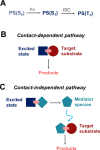Mechanisms of Photosensitized Lipid Oxidation and Membrane Permeabilization
- PMID: 31891041
- PMCID: PMC6933592
- DOI: 10.1021/acsomega.9b03244
Mechanisms of Photosensitized Lipid Oxidation and Membrane Permeabilization
Abstract
Lipid oxidation encompasses chemical transformations affecting animals and plants in many ways, and light is one of the most common triggers of lipid oxidation in our habitat. Still, the molecular mechanisms and biological consequences of photoinduced lipid oxidation were only recently understood at the molecular level. In this review, we focus on the main mechanisms of photosensitized lipid oxidation and membrane permeabilization, dissecting the consequences of both singlet oxygen and contact-dependent pathways and discussing how these reactions contribute to chemical and biophysical changes in lipid membranes. We aim to enable scientists to develop novel and more efficient photosensitizers in photomedicine, as well as better strategies for sun protection.
Copyright © 2019 American Chemical Society.
Conflict of interest statement
The authors declare no competing financial interest.
Figures




Similar articles
-
Photosensitized Membrane Permeabilization Requires Contact-Dependent Reactions between Photosensitizer and Lipids.J Am Chem Soc. 2018 Aug 1;140(30):9606-9615. doi: 10.1021/jacs.8b05014. Epub 2018 Jul 23. J Am Chem Soc. 2018. PMID: 29989809
-
Understanding membrane remodelling initiated by photosensitized lipid oxidation.Biophys Chem. 2019 Nov;254:106263. doi: 10.1016/j.bpc.2019.106263. Epub 2019 Sep 5. Biophys Chem. 2019. PMID: 31629920 Review.
-
Determination of singlet oxygen-specific versus radical-mediated lipid peroxidation in photosensitized oxidation of lipid bilayers: effect of beta-carotene and alpha-tocopherol.Biochemistry. 1997 Oct 21;36(42):12911-20. doi: 10.1021/bi9708646. Biochemistry. 1997. PMID: 9335550
-
Lipid Unsaturation Properties Govern the Sensitivity of Membranes to Photoinduced Oxidative Stress.Biophys J. 2019 Mar 5;116(5):910-920. doi: 10.1016/j.bpj.2019.01.033. Epub 2019 Feb 2. Biophys J. 2019. PMID: 30777304 Free PMC article.
-
Type I and Type II Photosensitized Oxidation Reactions: Guidelines and Mechanistic Pathways.Photochem Photobiol. 2017 Jul;93(4):912-919. doi: 10.1111/php.12716. Epub 2017 Mar 27. Photochem Photobiol. 2017. PMID: 28084040 Free PMC article. Review.
Cited by
-
Hypothetical Pathway for Formation of Cholesterol Microcrystals Initiating the Atherosclerotic Process.Cell Biochem Biophys. 2020 Sep;78(3):241-247. doi: 10.1007/s12013-020-00925-2. Epub 2020 Jun 30. Cell Biochem Biophys. 2020. PMID: 32602057 Free PMC article.
-
Directly imaging emergence of phase separation in peroxidized lipid membranes.Commun Chem. 2023 Jan 17;6(1):15. doi: 10.1038/s42004-022-00809-x. Commun Chem. 2023. PMID: 36697756 Free PMC article.
-
Stereoselectivity of Interaction of Nonsteroidal Anti-Inflammatory Drug S-Ketoprofen with L/D-Tryptophan in Phospholipid Membranes.Membranes (Basel). 2022 Apr 24;12(5):460. doi: 10.3390/membranes12050460. Membranes (Basel). 2022. PMID: 35629787 Free PMC article.
-
Visible light potentiates rapid cell destruction and death by curcumin in vitro.Photochem Photobiol Sci. 2024 Oct;23(10):1893-1914. doi: 10.1007/s43630-024-00639-x. Epub 2024 Sep 27. Photochem Photobiol Sci. 2024. PMID: 39333349
-
Curvature-Assisted Vesicle Explosion Under Light-Induced Asymmetric Oxidation.Adv Sci (Weinh). 2024 Oct;11(38):e2400504. doi: 10.1002/advs.202400504. Epub 2024 Aug 13. Adv Sci (Weinh). 2024. PMID: 39136143 Free PMC article.
References
-
- Bacellar I. O. L.; Oliveira M. C.; Dantas L. S.; Costa E. B.; Junqueira H. C.; Martins W. K.; Durantini A. M.; Cosa G.; Di Mascio P.; Wainwright M.; et al. Photosensitized Membrane Permeabilization Requires Contact-Dependent Reactions between Photosensitizer and Lipids. J. Am. Chem. Soc. 2018, 140 (30), 9606–9615. 10.1021/jacs.8b05014. - DOI - PubMed
Publication types
LinkOut - more resources
Full Text Sources
